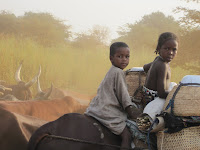


The best part of our patrols is seeing the children. They are almost always all smiles, incredibly curious of the "Kawajas" (which means foreigners or white guys). For many, the UN personnel are probably the only non-black skinned people they have ever seen in their lives. I always try to stop and speak to them, and am pleasantly surprised to hear many speak a lot of English (so there must be some schooling out there somewhere). Amazing, when you consider the town we live in has only two, barrack-dorm style schools for hundreds of children, almost no school supplies, few desks, hardly anything at all.
The two girls in the photo above are carrying home groceries for their family - on their heads, mid-day, 40 degrees, wearing only flip flops. Not sure where they were going, but the nearest hut or Tukel was about 3 kms away!
The other two photos are of some children who kept looking in the window of a commanders house/office when we were making a visit to a nearby military camp. One little girl came all the way in to see us! Of course, the commander refused to speak to us, because he had "not been informed of our visit", despite our coordinating it with his HQ two days before, so basically we had to return without meeting anyone. Not an unusual occurance. At least the kids made it a worthwhile visit.
Ultimately, the children are one of the few signs of hope around.
























